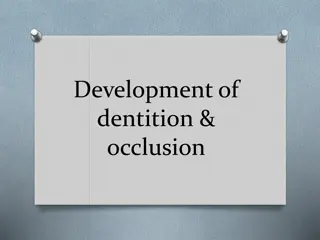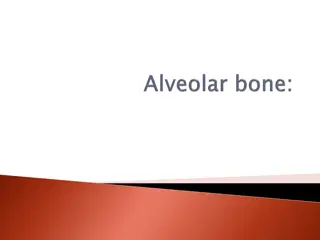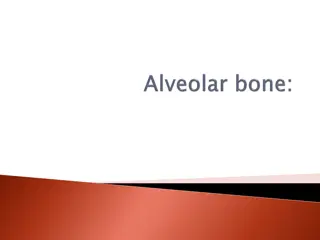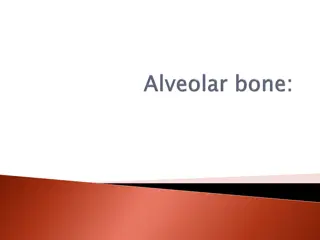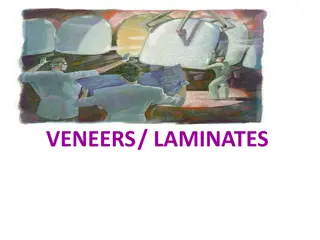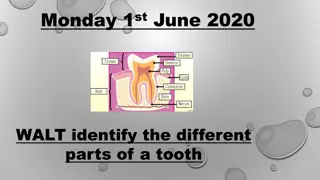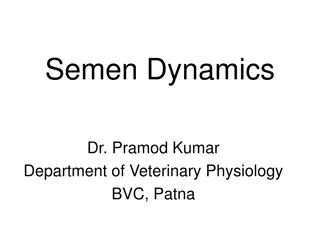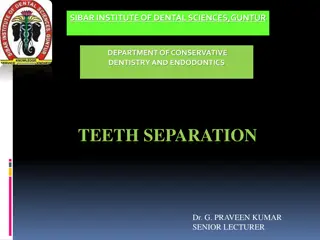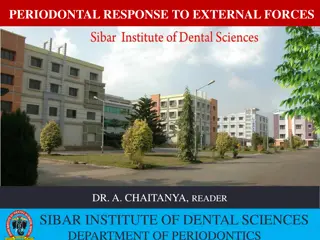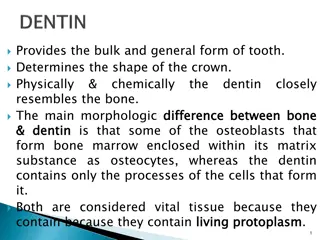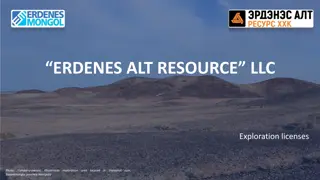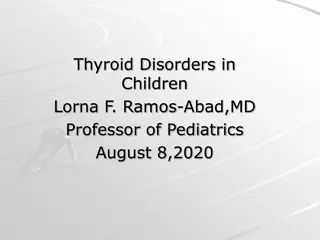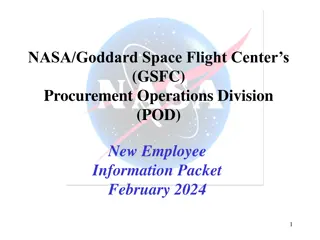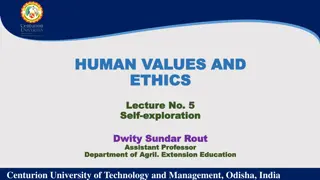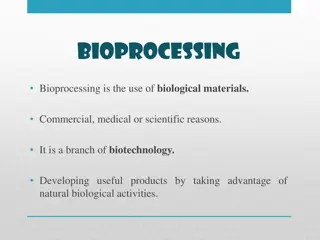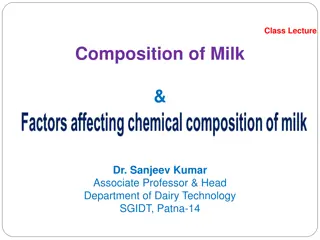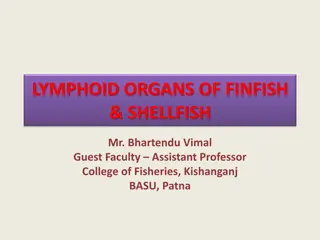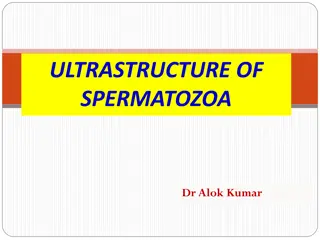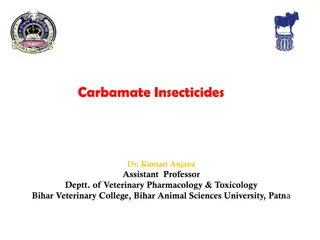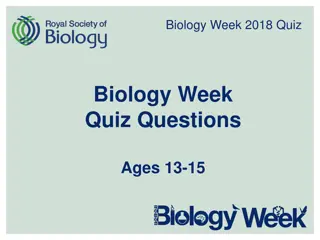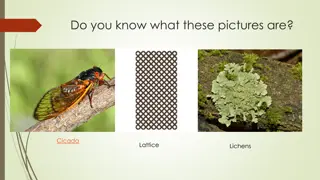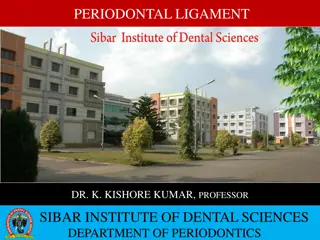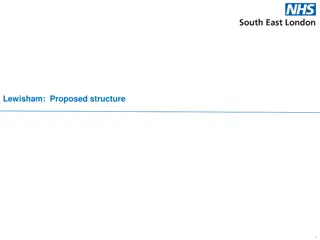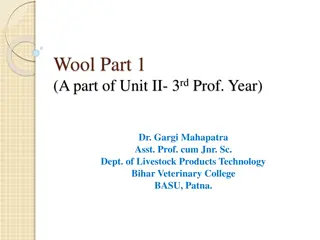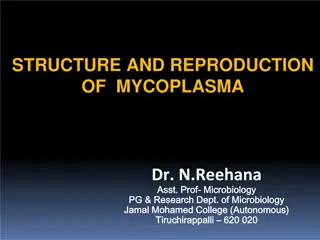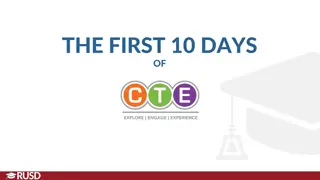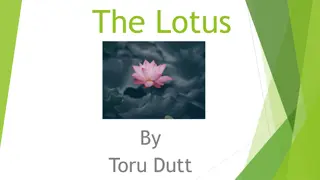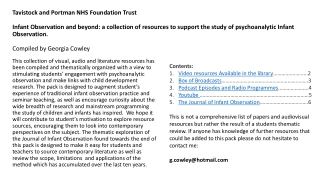Mammalian Dentition and Tooth Structure Exploration
Understanding dentition in mammals sheds light on their evolution, classification, age approximation, and dietary habits. The arrangement of teeth, tooth structure, development, and types of mammalian teeth are discussed, highlighting unique features like thecodont attachment, enamel coating, and dental papilla development.
Download Presentation

Please find below an Image/Link to download the presentation.
The content on the website is provided AS IS for your information and personal use only. It may not be sold, licensed, or shared on other websites without obtaining consent from the author. Download presentation by click this link. If you encounter any issues during the download, it is possible that the publisher has removed the file from their server.
E N D
Presentation Transcript
Dentition in mammals Dr Lt Santhosh S Asst Professor PG Department of Zoology
Dentition : the arrangement of teeth in upper and lower jaw Most specialized in mammals Teeth present in all mammals except in Platypus & Whale bone whales (teeth absent in adult condition)
Teeth present in all mammals except the following Platypus Embryonic teeth are replaced in adult by horny epidermal plates for crushing molluscs Whale bone whales Foetal teeth are replaced in adult by baleen plates for straining the planktonic food Ant-eaters Teeth not present even in early stages
Importance of dentition study Helps in tracing evolution Helps in classification Gives an idea of approximate age of the mammal Provides clue to the diet of mammal
Structure of tooth In mammals tooth is firmly fixed in a socket in the jaw-bone, hence called thecodont Some portion lie within jaw-bone & some portion lies outside it. Typical mammalian tooth has 3 regions a crown, a root & a short neck between them Tooth is made up of dentine, & coated with enamel on the crown & with cement in the root. Gum covers neck region Pulp cavity inside tooth with gelatinous connective tissue or pulp containing blood vessels and nerves In incisors of elephants and rodents, pulp cavity remains open basally so that teeth continue growing throughout life and termed open rooted In other mammals, pulp cavity becomes closed at a certain age so that nourishment stops and further growth stops : close- rooted
Development of tooth Tooth arises as the dermal or dental papilla on jaws Outer columnar cells differentiate into odontoblasts which secrete a layer of dentine on their outer surface A cap of hard enamel is formed around top & sides of dentine No enamel on root Central portion of dental papilla gives rise to the pulp which nourishes the tooth
Kinds of mammalian teeth Heterodont Dissimilar in shape and size (all other vertebrates-homodont) Incisors, canines, premolars & molars Diphyodont (most mammals) Two sets of teeth in life history 1stset deciduous/lacteal/milk teeth They erupt usually after birth (in guinea pigs & bat, they form and shed even before birth) Milk dentition has no premolars If lost they are not replaced In platypus, whales, moles, etc there is only one set of teeth throughout life - monophyodont
Incisors Front teeth borne by the premaxilla in upper jaw & by the tips of dentaries in lower jaw Single rooted & monocuspid Used for seizing and cutting In rodents (rabbit) incisors are open rooted continue to grow- have a sharp edge & chisel like form for cutting and gnawing In lemurs incisors are denticulate like a comb- for cleaning fur In elephants upper incisors are greatly elongated to form two large tusks contains entirely of dentine, there being no enamel coating In sloths, incisors are totally absent In ox they are lacking on upper jaw
Canines Simple conical tooth with single root Occurs outside the incisors Well developed in carnivores Absent in herbivores (diastema space) Monocuspid crown for tearing body of prey Long and sharp in cats and dogs Upper canine form tusks in Walrus for digging molluscs and for locomotion in ice
Cheek teeth Premolars and molars Have more than one cusp and more than one root Premolars have two roots and two cusps Molars have more than two roots and several cusps Cheek teeth for crushing, grinding and chewing In man last molar is called wisdom tooth erruption may be delayed (18 yrs age to 22 yrs) In carnivores last premolars in upper jaw and first molar in lower jaw are called carnassial teeth have very sharp cusps for cracking bones and shearing tendons
Various types of cheek teeth Triconodont Have 3 cones in a straight line fossil mammals Trituberculate 3 cusps in the form of a triangle primitive type in fossil mammals Bunodont Low conical cusps meant for crushing in mammals with a mixed diet monkey, man, pigs Lophodont Cusps are connected by several transverse ridges called lophos adapted to grind all sorts of plants in elephants Selenodont Molar teeth with vertical crescent-shaped ridges camel Brachyodont Molar teeth with low crowns and short roots cow Hypsodont Molar teeth with high crowns and short roots horse Secodont Cusps having sharp cutting edges for tearing and cutting fleshes - carnivores
Modifications of teeth according to the diet Herbivorous mammals Canines are reduced/absent leaving a gap called diastema Cheek teeth are broad with transverse ridges elephant Insectivorous mammals Upper & lower incisors are elongated & form a pair of forceps to catch insects (hedgehogs & moles) Plankton feeding mammals Teeth are lost and replaced by numerous horny plates called baleen plates (whale-bone whales) Piscivorous Teeth are similar, recurved and conical to hold the slippery fish- dolphin Carnivorous Incisors are small and canines elongated and pointed dogs, bears, cats, etc
Dental formula i, c, pm and m Teeth on each half of upper & lower jaws are expressed in dental formula Number of teeth shown in formula multiplied by 2 gives the total no. of teeth Teeth of upper jaw are placed in numerator and that of lower jaw are placed in the denominator of the formula
3.1.4.3 = 44 (typical mammalian dental formula) 3.1.4.3 Man 2.1.2.3 2.1.2.3 Cat 3.1.3.1 3.1.2.1 Rabbit 2.0.3.3 1.0.2.3 Elephant 1.0.0.3 0.0.0.3 Dog 3.1.4.2 3.1.4.3 Rat 1.0.0.3 1.0.0.3
Evolution of teeth Trituberculate theory of Cope & Osborn A trituberculate molar tooth evolved from a simple conical reptilian type tooth by the development of two more cusps In the process of development of this condition, at first three cusps arouse in a line, (triconodont pattern) and then became arranged in a triangular form by a rotation of these cusps This tooth might have given rise to several other patterns Concrescence theory of Rose Molar tooth has evolved by the fusion of a number of simple conical teeth like of reptiles This theory has only theoretical value and hence discarded


